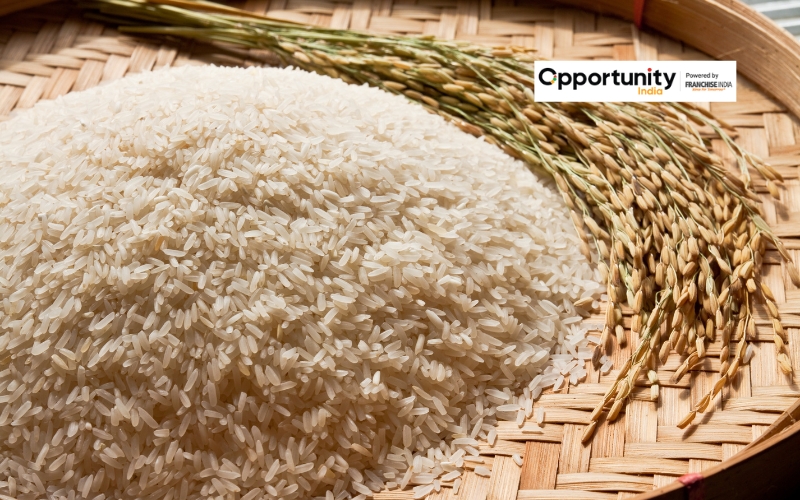
Have you ever thought of starting a rice mill, but don’t know the business plan yet? In Indian households, rice is not just a staple but the main one. Everybody eats rice, whether it's in North Indian biryanis or South Indian dosas. Therefore, a rice mill could be a fantastic opportunity if you're considering starting a successful, useful, consistently needed business. This business can provide you with stability in your entrepreneurial journey. This blog is a step-by-step guide to starting a rice mill business plan in India.
The Indian Rice Market
Businesses have a great opportunity to invest in rice milling because India is one of the biggest producers of rice. A rice milling business helps with agricultural value addition, rural employment, and food processing and distribution. A business in rice milling can be ideal if you want to get into a steady, long-lasting industry.
Also Read: How to Start a Laundry Business in 2025 – Low Investment, High Returns
For entrepreneurs wishing to enter the rice milling sector, India, the second-largest consumer of rice in the world, offers a favorable environment. Since rice is a staple food for a large portion of the population, demand is constantly high, making it a potentially profitable industry. However, careful preparation, a significant financial commitment, and a thorough understanding of the operating environment are necessary for success in this field.
In 2024, the size of the Indian rice market was estimated at USD 10.12 billion. According to IMARC Group's forecast, the market would grow at a compound annual growth rate (CAGR) of 2.1% from 2025 to 2033, reaching USD 12.21 billion. The growing population, rising domestic consumption, government assistance through the Minimum Support Price (MSP), improved irrigation infrastructure, climate-friendly rice varieties, growing exports, and technological advancements in farming are all contributing factors to India's growing market share in the rice industry.
The rice milling industry in India is undergoing a major transition at the moment. Due to rising customer demand for premium, processed, and frequently pre-packaged rice, there is an obvious move toward more automated and modernized rice mills. Government programs and regulations, which provide incentives and support for infrastructure development and technology advancements, are also very important.
The Main Key Drivers:
- Growing Demand: India's growing population and increased per capita rice consumption are the main factors driving this growing need. The demand for quick and varied rice products is further fueled by urbanization and shifting dietary patterns.
- Export Potential: India is a big exporter of rice, especially Basmati rice, which accounts for a sizable portion of the nation's overall rice exports. For mills, this presents a significant chance to access global markets.
- Regional Production Hubs: As major rice-producing states, West Bengal, Uttar Pradesh, Andhra Pradesh, Punjab, Tamil Nadu, Orissa, Bihar, and Chhattisgarh are perfect places to establish mills because of their convenient access to raw materials.
- Modernization: To increase productivity, decrease waste, and improve product quality, the industry is embracing cutting-edge technology, including color sorters, automated cleaning systems, and energy-efficient designs.

Types of Rice Mill Business Models
Before starting, choose the right model:
| Business Model | Description |
|---|---|
| Mini Rice Mill | Low-cost model (1–2 tonnes/hour); ideal for rural areas. |
| Semi-Automatic Mill | Medium investment with partial automation. |
| Fully Automatic Mill | High-end setup for large-scale production and export. |
| Custom Milling Unit | Offers milling service to farmers for a fee. |
Also Read: Start Your Dream Cosmetic Business with This Foolproof Business Plan
Step-by-Step Rice Mill Business Plan Guide
A solid business plan is essential to any successful endeavor. It should cover the following essential areas for a rice mill:
Executive Summary
A brief overview of your company's goals, mission, and vision. Emphasize your rice mill's distinctive features and unique marketing proposal.
Do Some Smart Research
Gaining a sense of the market is crucial before making a big move. Look around you. Is there a lot of demand for rice? Do other rice mills already exist? If so, what are they doing well—or poorly? Speak with nearby farmers, retailers, or even mandi vendors. Knowing the kind of rice that people prefer, such as parboiled, Sona Masoori, or Basmati, will help you choose what to emphasize. You may save a lot of time and money later on by doing a little homework at first.
Pick the Perfect Location
Next up — location. This decision might make or destroy the situation. Ideally, your rice mill should be close to grain mandis or paddy fields. Why? You will pay less for transportation if you are near your raw supplies. Make sure there is adequate space for storing raw paddy, processed rice, equipment, and packaging supplies, as well as that the place has dependable electricity and sufficient road connectivity. You'll be glad you picked a location that facilitates everyday operations.
Create a Robust Business Plan
It's time to put pen to paper, or fingers to keyboard. Your business plan serves as a guide. Establish a clear goal at the outset: Will you be focusing on exports or local markets? Provide information regarding your anticipated revenue, running costs, startup costs, and profit margins. Remember to account for potential hazards, such as fluctuations in rice prices or seasonal supply problems. If necessary, a solid plan will also make it simpler to attract investors or obtain bank loans.
Also Read: 12 Sustainable Business Ideas in 2025
Register Your Business and Get the Licenses
Legal registration is necessary, regardless of how tiny you are starting. If you want to keep things simple, you can choose a sole proprietorship; if you have bigger plans, you can choose a private limited company. A factory license if you have machinery, an FSSAI license (because rice is a food product), an MSME/Udyam registration, and a Pollution Control Board NOC are necessary after that. You will also want an Import Export Code (IEC) if you intend to export. Although it may seem like a lot, most of this can now be completed online.
Purchase the Right Machinery
The core of your rice mill is the machinery. Equipment such as a paddy cleaner, de-stoner, husker, separator, polisher, and grader will be required. A boiler and a dryer are also required if you plan to parboil your rice. Purchasing dependable devices from reputable brands may be more expensive initially, but they will ultimately save you money by preventing frequent malfunctions and losses. Additionally, find out whether local after-sales support is offered.
Hire Skilled and Reliable Staff
You can't manage the entire operation by yourself, even if you're just getting started. A few competent operators for the equipment, some assistants for loading and packing, and perhaps an accountant or administrative assistant to manage your daily paperwork are all necessary. Think about adding a marketing specialist and a quality control supervisor if you intend to grow. Remember that properly training your staff is just as crucial as employing them.
Procure Raw Material
Your raw material determines the quality of your final product. Thus, establish connections with trustworthy paddy suppliers. These could be cooperatives, mandi dealers, or even nearby farms. You can persuade farmers to provide you directly by offering them somewhat better prices. By doing this, you can avoid middlemen and obtain competitively priced, fresh, high-quality paddy. For year-round operations, make sure to purchase during harvest season and store it appropriately.
Also Read: Start a Makhana Snacks Business from Home
Start the Production Process
The exciting phase is about to begin: the milling process! Cleaning and drying the paddy should come first. Next, proceed with sorting, grading, polishing, and separating the rice. The next step is packing, ideally in neat, branded bags that appear polished. Throughout the procedure, monitor the quality to ensure that your rice satisfies market requirements. You can charge a higher fee for superior quality.

Investment Required for Rice Mill Business in India (2025)
Here’s a general idea of how much it’ll cost to start:
Mini Rice Mill (1–2 TPH capacity):
- Land (if rented): ₹0 – ₹1 lakh
- Shed and basic infrastructure: ₹3 – ₹5 lakhs
- Machinery: ₹6 – ₹10 lakhs
- Licenses & setup: ₹1 lakh
- Raw material & working capital: ₹3 – ₹5 lakhs
- Total investment: ₹15 – ₹25 lakhs
Also Read: Pokkali Rice Farming Business in India
Medium to Large Unit (5–8 TPH capacity):
- Land & building: ₹15 – ₹30 lakhs
- High-capacity machinery: ₹30 – ₹50 lakhs
- Licenses, labor, and working capital: ₹20 – ₹25 lakhs
- Total investment: ₹70 lakhs – ₹1.2 crore
Pro tip: You can apply for Mudra loans, NABARD assistance, or loans under MSME schemes to reduce your burden.
One of the best business decisions you can make in 2025 is opening a rice mill in India, particularly if you come from an agri-based area or have farming experience. With strong market potential and government backing, launching a rice mill business in India can be quite profitable. Success depends on careful planning, investment, and market strategy, regardless of whether you start with a small unit or strive for full-scale automation.

